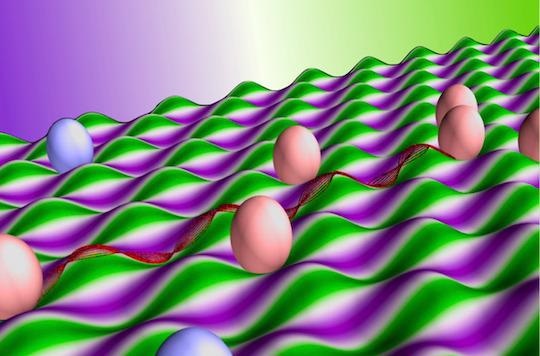Graphene, when spread across a wavy surface, provides a glimpse of one possible future of two-dimensional electronics.
 A theory by Rice researchers suggests growing graphene on a surface that undulates like an egg crate would stress it enough to create a minute electromagnetic field. The phenomenon could be useful for creating 2D electron optics or valleytronics devices. Image Credit: Illustration by Henry Yu.
A theory by Rice researchers suggests growing graphene on a surface that undulates like an egg crate would stress it enough to create a minute electromagnetic field. The phenomenon could be useful for creating 2D electron optics or valleytronics devices. Image Credit: Illustration by Henry Yu.
According to Rice University researchers, growing atom-thick graphene on a gently textured surface produces peaks and valleys in the sheets, turning them into “pseudo-electromagnetic” devices.
Magnetic fields are created by the channels, which are minute but detectable. According to a study by Rice’s George R. Brown School of Engineering materials theorist Boris Yakobson, alumnus Henry Yu, and research scientist Alex Kutana, these could help nanoscale optical devices such as converging lenses or collimators.
The research was published in the American Chemical Society’s Nano Letters.
They also guarantee a method for achieving a Hall effect - a voltage difference across the strongly conducting graphene - which could help valleytronics applications modify how electrons are trapped in “valleys” in an electronic band structure.
Valleytronics is associated with spintronics, in which the quantum spin state of an electron determines the memory bits of a device. In valleytronics, on the other hand, electrons have degrees of freedom in the multiple momentum states (or valleys) they inhabit. These can be read as bits as well.
This is possible because graphene is pliable enough to adhere to a surface during chemical vapor deposition, despite being one of the strongest known structures.
Substrate sculpting imparts deformation, which in turn alters the material electronic structure and changes its optical response or electric conductivity. For sharper substrate features beyond the pliability of the material, one can engineer defect placements in the materials, which creates even more drastic changes in material properties.
Henry Yu, Postdoctoral Researcher, Lawrence Livermore National Laboratory
The process, according to Yakobson, is similar to depositing a sheet of graphene on an egg crate. Even without electrical or magnetic input, the bumps in the crate deform the graphene, stressing it in a manner that produces an electromagnetic field.
The endless designs of substrate shapes allow for countless optical devices that can be created, making possible 2D electron optics. This technology is a precise and efficient way of transmitting material carriers in 2D electronic devices, compared to traditional methods.
Boris Yakobson, Materials Theorist, George R. Brown School of Engineering, Rice University
Yakobson is the Karl F. Hasselmann Professor of Materials Science and NanoEngineering and a professor of chemistry.
The study was supported by the Office of Naval Research (N00014-18-1-2182) and the Army Research Office (W911NF-16-1-0255).
Journal Reference:
Yu, H., et al. (2022) Electron Optics and Valley Hall Effect of Undulated Graphene. Nano Letters. doi.org/10.1021/acs.nanolett.2c00103.